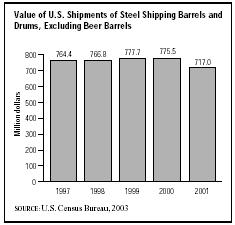SIC 3412
METAL SHIPPING BARRELS, DRUMS, KEGS, AND PAILS
This category includes establishments primarily engaged in manufacturing metal shipping barrels, drums, kegs, and pails.
NAICS Code(s)
332439 (Other Metal Container Manufacturing)
According to the U.S. Census Bureau, roughly 150 establishments operate in this category. Industry wide employment totaled 17,507 workers receiving a payroll of more than $556 million; 13,706 of these employees worked in production, putting in more than 28 million hours to earn wages of almost $364 million. Overall shipments for the industry were valued at more than two billion dollars in 2001.
Dallas-based Trinity Industries Inc. led the industry with sales of over $1.4 billion for its fiscal year ended December 31, 2003. Menasha Corp. of Neenah, Wisconsin, a fifth-generation privately owned firm, followed

with $1.1 billion in 2002 sales. Greif Inc., formerly known as Greif Bros. Corp., of Delaware, Ohio, rounded out the top three industry leaders with sales of $1.9 billion for its fiscal year ended October 31, 2003. Other industry leaders included Longview Fibre Co. of Long-view, Washington, with 2003 sales of $773 million; Park-Ohio Holdings Corp. of Euclid, Ohio, with 2003 sales of $624 million; and privately owned Russell-Stanley Corp. of Bridgewater, New Jersey, which in late 1999 had introduced a new 55-gallon tight head steel drum with a "W" style hoop enclosure for maximum freight usability and vacuum seal.
Steel shipping barrels and drums, excluding beer barrels, accounted for more than 35.7 percent of total industry shipments. Steel pails claimed 26.5 percent of shipments. The remainder of the market was split between non-specific barrels, drums, pails, and other metal containers. After climbing from $2.21 billion 1997 to $2.31 billion in 2000, total industry shipments declined to two billion dollars in 2001. Steel pail shipments followed a similar pattern, climbing from $530.1 million in 1997 to $567.1 million in 2000, before declining to $531.6 million in 2001. Shipments of steel shipping barrels and drums climbed from $764.4 million in 1997 to $777.7 million in 1999, before falling to $775.5 million in 2000 and $717 million in 2001.
Five states held well over one-half of the industry's establishments and accounted for roughly 60 percent of U.S. sales. Illinois proved to be the leader in terms of number of establishments and in value of shipments of metal barrels, drums, kegs, and pails. Ohio held the second place spot, followed by Texas, California, and Pennsylvania. Illinois' workers averaged the highest wages, while hourly workers in Texas were paid the lowest wages.
Employment levels of most occupations in this industry were expected to decline approaching the year 2005. Those facing reductions of more than 40 percent were machine feeders (expected to decline 40.4 percent), metal/plastic workers (a 41.3 percent decline), maintenance and repairers (40.5 percent), hand packers (43.3 percent), punching machine operators (47 percent), material handlers (47.1 percent), miscellaneous machine operators (41.6 percent), and welding machine setters (40.4 percent). All other types of employment were expected to decline by about 35 percent by 2005.
Modifications in the design of steel drums and higher quality steel have improved drum and pail performance considerably. The U.S. Department of Transportation has also helped in improving the quality of the industry when their Performance-Oriented Packaging Standards went into effect in October of 1996. The new standards called for better formed individual drum parts, improved gasket and closing rings, and more secure joining of individual parts.
Both the improvement of technology and superior steel products have made incredible improvements to the drum and barrel industry. Computer controlled operations within the steel processing industry have improved thickness tolerances, resulting in stronger, yet thinner steel, and also eliminated pinholes. This meant that steel container manufacturers in the late 1990s and early 2000s had far better raw materials than they had just a few years before.
Further Reading
Infotrac Company Profiles. 29 January 2000. Available from http://web2.infotrac.galegroup.com .
U.S. Census Bureau. "Statistics for Industry Groups and Industries: 2000." February 2002. Available from http://www.census.gov/prod/2002pubs/m00as-1.pdf .
——. "Value of Shipments for Product Classes: 2001 and Earlier Years." December 2002. Available from http://www.census.gov/prod/2003pubs/m01as-2.pdf. .
Comment about this article, ask questions, or add new information about this topic: